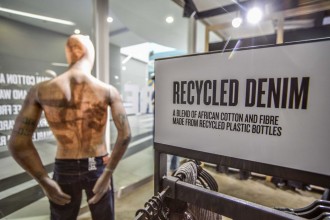Earlier this month, Levi’s announced the Fall 2015 launch of the Levi’s Wellthread™ Collection, which touts a holistic approach to sustainable product design: The line was made in 100 percent cotton for easier recyclability, by empowered workers — and includes the first garments to feature Levi’s Water<Less™ fabric, which saves more than 65 percent of the water in the dye process, as well as Water<Less denim finishes, which use up to 50 percent less water.
Levi Strauss & Co. has led the charge in dramatically reducing the environmental impact of its garments by improving the efficiency of its processes: As the company announced in March, it has saved more than 1 billion liters of water since the inception of its Water<Less™ process in 2011.
Levi’s unveiled the Dockers® Wellthread process for responsible sourcing — which combines sustainable design and environmental practices with an emphasis on durable materials and supporting the well-being of the workers who make the garments — in 2013.
“How you make a garment is just as important as the garment itself,” Michael Kobori, Levi’s VP of social and environmental sustainability, said at the time. “We believe that we can use our iconic brands to drive positive sustainable change and profitable results. We invented a category and with that comes the responsibility to continually innovate for each new generation of consumers.”
The Dockers Wellthread design team studied garments from the company’s historical archives to see how clothing has held up over time, and created a pilot collection of khakis, jackets and T-shirts. The team engineered lasting value into the design process by reinforcing garments’ points of stress, while making buttonholes stronger and pockets more durable.
Now, the new Wellthread collection incorporates slight modifications to further improve durability. For example, laser processing replaced mechanical abrasion, which can degrade the strength of garments; and the pocket flap on the Western shirt was modified slightly to reduce strain and breakage where the pocket is joined to the shirt.
The full denim wash range capitalizes on Water<Less™ processes, including the introduction of Water<Less fabric in the 511™ Slim Fit Jean and Trucker jacket. T-shirts were produced using water-saving cold-water pigment dyes.
As Paul Dillinger, Levi’s head of global product innovation, said at Sustainable Brands 2015 in Barcelona: We’re delivering goods that are the same as always, like never before. The Wellthread design methodology seeks to create environmental or social value creation at every point in the design process — allowing the design team to make the right choice whenever a choice is made.”
Of course, Levi’s can only manage the impact of its garments through the point of sale, at which point the wearer must do his or her part to continue the effort. The Wellthread line comes with friendly care instructions to guide wearers in responsible home-laundry habits, which are aided by design modifications to facilitate proper care of the garments: For example, the overlapping panel at the shoulder of the t-shirts allows for hang drying without stretching it out. And as with all of Levi’s jeans, the Care Tag for the Planet provides the simple care instructions: wash less, wash cold, and line dry.
With the new Wellthread line, Levi’s is also investing in the health and financial empowerment of the people who made the clothes, from Haiti to Sri Lanka. Examples include programs that help promote financial literacy and women’s health and family wellness, along with water purifiers and solar lamp access to nutrition education.
And as with Levi’s® products in general, the company says it is committed to sourcing cotton that uses less water and less pesticide while improving the livelihood of farmers.











